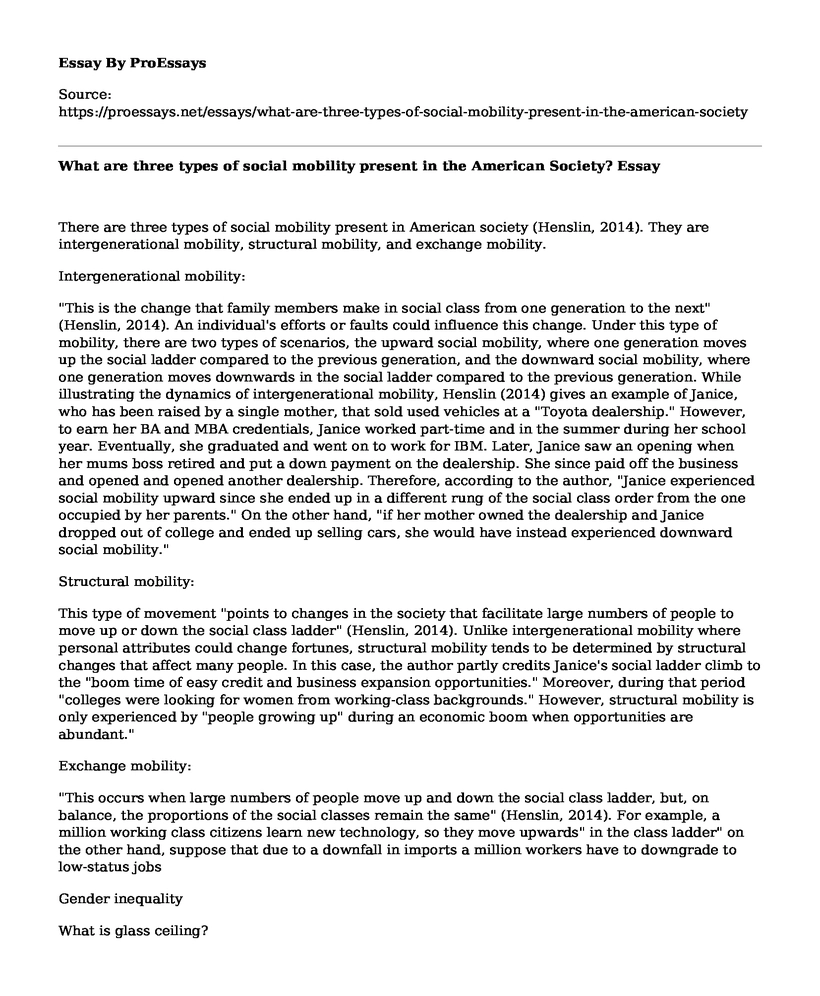There are three types of social mobility present in American society (Henslin, 2014). They are intergenerational mobility, structural mobility, and exchange mobility.
Intergenerational mobility:
"This is the change that family members make in social class from one generation to the next" (Henslin, 2014). An individual's efforts or faults could influence this change. Under this type of mobility, there are two types of scenarios, the upward social mobility, where one generation moves up the social ladder compared to the previous generation, and the downward social mobility, where one generation moves downwards in the social ladder compared to the previous generation. While illustrating the dynamics of intergenerational mobility, Henslin (2014) gives an example of Janice, who has been raised by a single mother, that sold used vehicles at a "Toyota dealership." However, to earn her BA and MBA credentials, Janice worked part-time and in the summer during her school year. Eventually, she graduated and went on to work for IBM. Later, Janice saw an opening when her mums boss retired and put a down payment on the dealership. She since paid off the business and opened and opened another dealership. Therefore, according to the author, "Janice experienced social mobility upward since she ended up in a different rung of the social class order from the one occupied by her parents." On the other hand, "if her mother owned the dealership and Janice dropped out of college and ended up selling cars, she would have instead experienced downward social mobility."
Structural mobility:
This type of movement "points to changes in the society that facilitate large numbers of people to move up or down the social class ladder" (Henslin, 2014). Unlike intergenerational mobility where personal attributes could change fortunes, structural mobility tends to be determined by structural changes that affect many people. In this case, the author partly credits Janice's social ladder climb to the "boom time of easy credit and business expansion opportunities." Moreover, during that period "colleges were looking for women from working-class backgrounds." However, structural mobility is only experienced by "people growing up" during an economic boom when opportunities are abundant."
Exchange mobility:
"This occurs when large numbers of people move up and down the social class ladder, but, on balance, the proportions of the social classes remain the same" (Henslin, 2014). For example, a million working class citizens learn new technology, so they move upwards" in the class ladder" on the other hand, suppose that due to a downfall in imports a million workers have to downgrade to low-status jobs
Gender inequality
What is glass ceiling?
The glass ceiling is an invisible barrier that stops members of a certain group from reaching great levels of hierarchies (Henslin, 2014).
How does it apply to women?
As Henslin ( 2014) states, women have long suffered in the workplace. This unfairness exists in the inequitable distribution of job positions especially in top management positions - the author further states that the discrimination against women in the workplace is also evident in the pay gap between men and women staff working in the same position. However, Henslin notes that according to recent developments the glass ceiling is cracking, this can be observed by the rising numbers of women taking up top positions in their careers.
Reply to Emma Vollraths post
There are three types of social mobility in American society. They are intergenerational mobility, structural mobility, and exchange mobility. Upward and downward mobility are movements under intergenerational mobility. The glass ceiling is an invisible barrier that places restrictions on certain groups barring them from advancing to certain hierarchies. Women have been affected by these barriers over time, but, due to higher education, and mentorship the glass ceiling is cracking.
References
Henslin, J, M. (2014). Sociology: a down-to-earth approach. Edwardsville. Illinois, Pearson's
.
Cite this page
What are three types of social mobility present in the American Society?. (2022, Oct 10). Retrieved from https://proessays.net/essays/what-are-three-types-of-social-mobility-present-in-the-american-society
If you are the original author of this essay and no longer wish to have it published on the ProEssays website, please click below to request its removal:
- Personal Essay Sample: Feeling of Being in the Presence of God
- Research Paper on Prison Abolition in Australia
- Essay on Yoga for Overall Good Health
- Minorities in Policing Essay Example
- 2017 Cybercrime: Establishing a Cybersecurity Insurance Firm - Essay Sample
- Free Essay Example: Transitioning from Childhood to Adolescent Self-Concept
- Driving Success: Analyzing the Costs and Benefits of Employee Motivation at Vroomz Company - Paper Example







